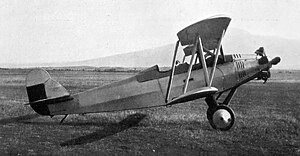The DAR 6 was a 1930s Bulgarian two-seat basic or advanced biplane training aircraft.
| DAR 6 | |
|---|---|

| |
| DAR 6 with engine Walter Vega | |
| Role | Training biplane |
| Manufacturer | DAR |
| Designer | Zevtan Lazarov |
| First flight | 1930s |
| Primary user | Bulgarian Air Force |
Design and development
editThe DAR 6 was designed by Zevtan Lazarov. It was constructed by the Bulgarian State Aircraft Workshops (DAR).
The aircraft was a conventional biplane with a fixed tailskid landing gear. It was powered by a radial engine.
Three versions were initially developed:
- Basic training version, powered by an 85 hp (63 kW) Walter Vega engine;
- Advanced training version, powered by a 145 hp (108 kW) Walter Mars I engine;
- 1937 Model DAR 6a. This variant offered faired struts and redesigned divided landing gear. It was powered by a 150 hp (112 kW) Walter Mars I engine.
Operators
editSpecifications (DAR 6)
editData from The Illustrated Encyclopedia of Aircraft, (Part Work 1982–1985), Orbis Publishing, Page 1295
General characteristics
- Crew: two, pilot and student
- Length: 6.85 m (22 ft 5.75 in)
- Wingspan: 9.05 m (29 ft 8.25 in)
- Height: 2.85 m (9 ft 4.25 in)
- Wing area: 19.30 m2 (207.75 sq ft)
- Empty weight: 510 kg (1,124 lb)
- Gross weight: 770 kg (1,697 lb)
- Powerplant: 1 × Walter Mars I radial piston engine , 108 kW (145 hp)
Performance
- Maximum speed: 180 km/h (112 mph, 97 kn)
- Range: 715 km (444 mi, 386 nmi)
References
editWikimedia Commons has media related to DAR 6.
Bibliography
edit- Bernád, Dénes (July–August 2001). "Balkan Birds: Thirty-Five Years of Bulgarian Aircraft Production, Part One". Air Enthusiast (94): 18–30. ISSN 0143-5450.
- The Illustrated Encyclopedia of Aircraft, (Part Work 1982–1985), Orbis Publishing, Page 1295